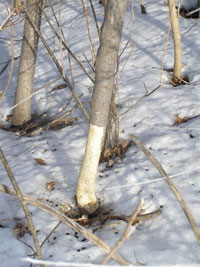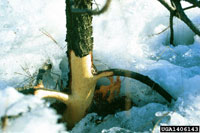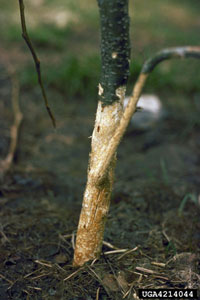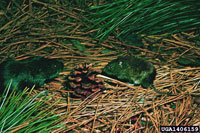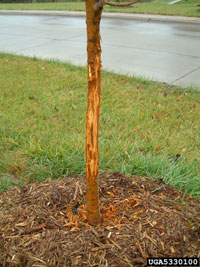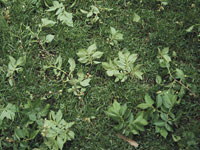Extension > Garden > Diagnose a problem > What's wrong with my plant? > Deciduous Trees > Honeylocust > Bark chewed or removed
Honeylocust > Branches > Bark chewed or removed
1 of 4
Rabbit feeding
- Bark is completely removed from the main trunk
- Regular scraping the size of a spoon tip can be seen in the wood
- Small twigs (of suckers) are cleanly cut off with a sharp edge, at a 45 degree angle
- Damage can occur from ground level to several feet up the trunk depending on the depth of winter snow
- Majority of damage occurs in winter and early spring
2 of 4
Vole feeding
- Bark is completely removed from the main trunk in irregular patches
- Scraping the size of a fork tine can be seen in exposed wood
- Damage occurs during winter from the ground level up to winter snow depth
3 of 4
Deer rubbing on young trees
- Long lines of shredded or peeled off bark along main trunk up to 3 feet off the ground from antler rubbing
- Wood may appear shiny or "polished"
- Leaves and small branches (>1 inch in diameter) cut off with a rough or ragged edge (Not a clean cut!)
- Feeding occurs from the ground up to 6 feet or slightly higher. Ragged edges, same as above, also if the bark is removed by a deer there will be no sign of teeth marks
- Damage is common only on young trees, old trees have thick bark and wide stem so are not used by deer for antler rubbing
- More information on Problems with deer
4 of 4
Gray squirrels
- In late winter, early spring bark of smaller branches is stripped and left hanging on branch, similar to confetti
- Whole leaf sections are removed from branches and dropped to ground
- Unusual numbers of complete, green leaves laying beneath the tree
- Damage usually occurs in late spring, early summer



